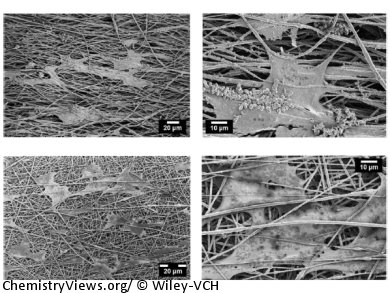Hybrid materials in nanotechnology offer a variety of potential applications for example in regenerative medicine. Hybrid nanofibers with diameters at nanometer scale and tens of meters in length are of special interest because of their large specific area and their porous structure. Titanium dioxide (TiO2-anatase) has photocatalytic activity upon UV-irradiation and also a biocidal effect against bacteria. However, due to problems concerning the removal of reacted TiO2 from suspensions wide application is not found yet.
Iliya Rashkov and colleagues, Bulgarian Academy of Sciences, Sofia, Bulgaria, describe a facile and effective approach for the preparation of novel multifunctional hybrid materials. Biodegradable nanofibers of poly(3-hydroxybutyrate) (PHB) are produced by electrospinning and nanoTiO2 is simultaneously applied by electrospraying. Impregnation with biocompatible chitosan-oligomers (COS) stabilizes the dispersion and serves as sticking agent for the fixation of nanoTiO2 onto the PHB fibers.
Due to the photocatalytic properties of TiO2 and its considerable biocidal effect against bacteria, these nanofibers were tested as matrices for the growth of human stem cells. Results show that the properties of the hybrid nanofibers have a favorable impact on stem cell development, making them promising matrices for regenerative medicine and tissue engineering.
- Multifunctional Hybrid Materials From Poly(3-Hydroxybutyrate), TiO2 Nanoparticles, and Chitosan Oligomers by Combining Electrospinning/Electrospraying and Impregnation,
Elena Korina, Olya Stoilova, Nevena Manolova, Iliya Rashkov,
Macromol. Biosci. 2013.
DOI: 10.1002/mabi.201200410




